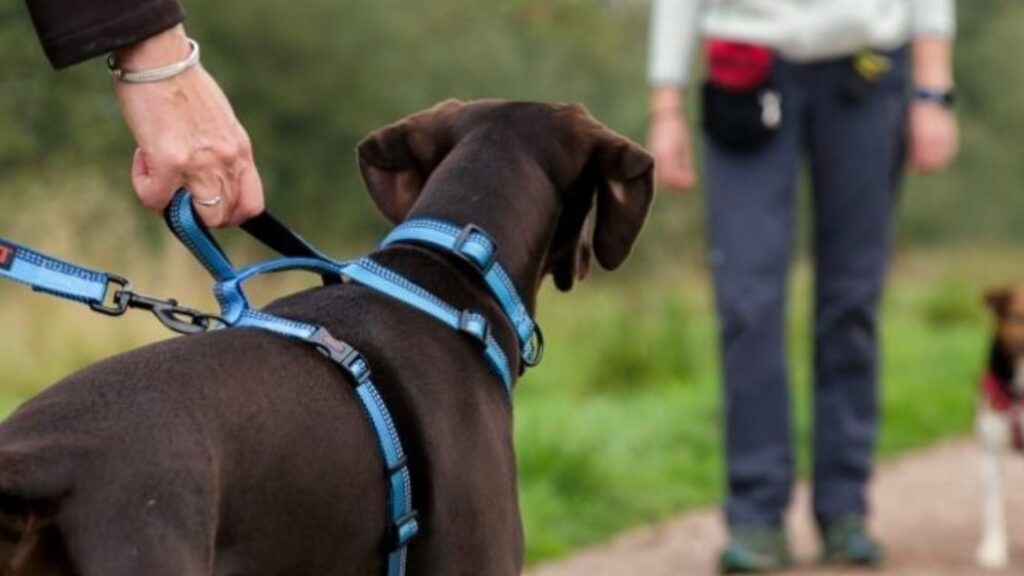How to walk A dog without A collar?

How to walk a dog without a collar?
Can I walk my dog without a collar? Absolutely! Many dog owners wonder about the necessity of collars, and the truth is, that walking your dog without one can be perfectly fine, depending on various factors.
Firstly, it’s essential to understand why some people choose not to use collars. Collars, if too tight or not properly fitted, can cause discomfort or even harm to your furry friend. Some dogs, especially those with respiratory issues, may find collars restrictive. However, it’s crucial to consider your dog’s size, behavior, and any local regulations regarding leash laws.
How to Walk a Dog Without a Collar: A Simple Guide
Now, let’s delve into the reasons why walking a dog without a collar might be preferred by some owners. In certain situations, dogs trained to respond to voice commands may not require a collar during walks. Moreover, some dogs have a tendency to pull excessively on a leash, leading owners to explore alternative walking methods, such as harnesses.
Despite these considerations, it’s essential to note that in most public places, using a collar on your dog is a legal requirement. It helps ensure the safety of your pet and others around you. Always check your local regulations to avoid any legal issues while enjoying a collar-free walk with your dog.
Why Some Opt Not to Use Collars
Dog owners choose not to use collars for various reasons. Firstly, improper collar use can lead to discomfort for the dog. If a collar is too tight or not fitted correctly, it may cause choking or even injury. This is particularly concerning for dogs with respiratory or neck issues.
Additionally, some dogs are not comfortable with the sensation of a collar around their necks. This discomfort can manifest in behavioral issues during walks, making the experience stressful for both the dog and the owner.
In certain cases, dogs that have been trained extensively to respond to voice commands may not need the physical restraint of a collar. However, this level of training requires time and effort, and not all dogs may be suitable candidates for off-leash walking.
It’s important to recognize that while some owners opt for collar-free walks, this choice must align with the dog’s comfort and safety, along with adherence to local laws and regulations.

Ensuring Safety and Comfort
The primary concern when walking a dog without a collar is ensuring the safety and comfort of your furry companion. Before deciding to go collar-free, consider factors such as your dog’s size, behavior, and any existing medical conditions.
For dogs that tend to pull excessively on a leash, alternative options like harnesses might provide better control and prevent strain on the neck. Always introduce these alternatives gradually, allowing your dog to get accustomed to the new equipment.
Remember, the ultimate goal is to create a positive and enjoyable walking experience for both you and your dog. Pay attention to your dog’s cues, and if you choose to go collar-free, ensure that you comply with local laws to avoid any legal complications.
While walking a dog without a collar is possible in certain situations, it’s crucial to prioritize your dog’s well-being and follow any legal requirements in your area. Whether you opt for a collar, harness, or other walking tools, the key is to make the experience pleasant and safe for your furry friend.
Can I walk my dog without a collar?
You can walk your dog without a collar in certain situations, fostering a more comfortable and enjoyable experience for your furry companion. Dogs, much like people, have unique preferences, and some may find the sensation of a collar around their necks bothersome. This is particularly true for dogs with respiratory issues or those who may have had negative experiences with collars in the past. In such cases, opting for collar-free walks can enhance your dog’s well-being and make outdoor activities a positive and stress-free experience.
However, it’s important to navigate this choice with an understanding of local leash laws and regulations. While the desire for a collar-free walk may stem from the best intentions for your dog’s comfort, many places mandate the use of collars during walks as a safety measure. Collars not only serve as a means of identification but also provide a way for owners to maintain control over their pets, preventing potential incidents. Familiarizing yourself with these regulations ensures that you can strike a balance between your dog’s preferences and legal requirements.
In addition to local laws, it’s advisable to assess your dog’s behavior and responsiveness to voice commands. Dogs that have undergone thorough training and reliably respond to verbal cues may navigate collar-free walks more effectively. Training plays a pivotal role in establishing a strong bond between you and your dog, fostering trust and reliability during leash-free outings. However, this level of training requires time, patience, and consistency, so it’s important to gauge your dog’s readiness for such activities.
While walking your dog without a collar can be a viable and enjoyable option in certain situations, it’s crucial to consider both your dog’s preferences and the legal requirements in your area. Striking a balance between comfort, safety, and adherence to local regulations ensures that both you and your furry friend can relish the outdoor experience.

Why not to walk dog on a collar?
Choosing not to walk a dog on a collar can be influenced by several important factors. First and foremost, improperly fitted collars can lead to discomfort or even harm for the dog, especially if they are too tight. Dogs, just like us, need to feel comfortable during their walks, and a poorly fitted collar can cause irritation or choking. This is particularly concerning for dogs with neck or respiratory issues, as they may find collars restrictive and unpleasant.
Moreover, some dogs may exhibit behavioral problems when walking on a collar, such as pulling excessively on the leash. This not only makes the walk less enjoyable for the owner but also for the dog. The constant strain on the neck can lead to discomfort and might even exacerbate existing health issues. In situations where dogs display such behaviors, pet owners often seek alternative options for walking, and one popular choice is using a harness. Harnesses distribute the pressure more evenly across the dog’s body, providing better control and preventing strain on the neck, making walks more comfortable and enjoyable for both the owner and the pet. In such cases, the use of a harness can be a practical and considerate alternative to ensure a pleasant walking experience for your furry friend.
Is it bad to walk a dog with a collar?
Walking a dog with a collar is generally a common practice, and it’s not inherently bad as long as certain considerations are taken into account. One key factor is using the right type of collar and ensuring that it fits properly. Dogs, much like humans, come in various shapes and sizes, and a well-fitted collar is essential for their comfort and safety during walks. Improperly fitted collars, especially those that are too tight, can cause discomfort, choking, or injury. It’s crucial for pet owners to select a collar that allows for a comfortable walking experience and to regularly check and adjust the fit, particularly as the dog grows.
For some dogs, especially those that haven’t been adequately trained to walk on a leash, collars might pose a challenge. Uncomfortable or restrictive collars can make walks stressful for both the dog and the owner. In such cases, it becomes important to consider alternative walking tools like harnesses. Harnesses distribute the pressure more evenly across the dog’s body, providing better control and preventing strain on the neck. This is particularly beneficial for dogs that have a tendency to pull excessively during walks. Positive reinforcement training methods can also play a significant role in teaching dogs to walk calmly on a leash, promoting a more enjoyable experience for both the owner and the pet.
It’s worth noting that if a dog is properly trained and understands your commands, walking without a collar can be a viable option. In such cases, the dog has learned to walk alongside its owner without the need for physical restraint. However, this level of training requires time, consistency, and positive reinforcement. Whether using a collar or exploring collar-free options, the key is to prioritize the dog’s comfort, safety, and overall enjoyment of the walking experience.

Is it illegal to walk a dog without a collar?
In many places, it is indeed illegal to walk a dog without a collar. These laws are in place to serve as a safeguard for the well-being of pets and the community. Collars play a crucial role in identifying dogs and ensuring that they remain under control during walks. The use of collars is often mandated by local leash laws, which vary from one place to another. These laws aim to prevent potential incidents and maintain a secure environment for both pets and people.
Violating leash laws by walking a dog without a collar can lead to various legal consequences, including fines. The enforcement of these laws underscores the importance of responsible pet ownership. Collars not only provide a means of identification, but they also allow owners to manage and control their dogs, preventing situations that could pose risks to the dog or others in the community. To avoid legal complications and contribute to a safe environment, it is crucial for pet owners to be aware of and adhere to the leash laws applicable in their area, ensuring that their dogs wear collars during walks as required by law.
Understanding and following these regulations is not only a legal obligation but also a way to promote the well-being of pets and maintain harmonious interactions in public spaces. It’s a simple yet effective measure that contributes to the overall safety and security of both dogs and the communities they are a part of.
My Strong Recommendation: Use a Harness
When it comes to taking your four-legged friend for a stroll, my recommendation is crystal clear: choose a harness over a collar. Harnesses provide better control, reducing the risk of injury and discomfort for your dog. Unlike collars, which can put a strain on the neck, harnesses distribute the pressure more evenly across the body. This not only promotes a safer walking experience but also minimizes the chance of any potential health issues. So, for a walk that’s both enjoyable and secure, my recommendation is to make the switch to a harness – your dog will thank you for it.

Conclusion
In conclusion, understanding how to walk a dog without a collar involves a thoughtful balance between your pet’s comfort and legal requirements. While walking without a collar may be suitable for well-trained dogs, it’s crucial to consider alternative tools like harnesses, especially for those with discomfort or behavioral issues. However, in many places, using a collar is a legal obligation to ensure identification and control. By staying informed about local leash laws and choosing the right walking tools, you can create a safe and enjoyable experience for both you and your furry companion.
This may also be helpful for you: What Size Collar For A Large Dog?
Should I Walk My Dog With A Collar Or Harness?
How Many Inches Is A Large Dog Collar?
How To Train Your Dog To Stop Barking At Night?
FAQ
What is the safest way to walk a dog?
The safest way to walk a dog is by using a sturdy leash and collar or harness. Ensure that the equipment fits properly to prevent slipping or discomfort. Leashes allow you to maintain control over your dog and prevent them from running into potentially dangerous situations. Additionally, be mindful of your surroundings, avoid busy roads, and consider using reflective gear for visibility, especially during low-light conditions.
How do I train my dog to walk without a leash?
Training a dog to walk without a leash requires a gradual process. Start in a secure, enclosed area and use positive reinforcement like treats to reward your dog for staying close. Increase the distance over time as your dog becomes more reliable. It’s essential to practice in a safe environment and only attempt off-leash walks when you are confident in your dog’s responsiveness to commands.
Is it better to walk a dog with or without a leash?
It is generally safer to walk a dog with a leash. A leash provides control and helps prevent your dog from running into potentially harmful situations, like traffic or encountering aggressive animals. While some well-trained dogs may walk off-leash, it’s important to consider your dog’s behavior, the environment, and any local leash laws to determine the safest approach for your specific situation.
How do you walk a dog with control?
Walking a dog with control involves using a properly fitted collar or harness and a leash of an appropriate length. Begin with basic obedience training to ensure your dog responds to commands like “sit” and “stay.” Use gentle corrections on the leash to guide your dog’s movements. Consistent training, positive reinforcement, and patience are key to walking your dog with control.
How do I master my dog to walk?
Mastering your dog’s walking behavior involves consistent training and positive reinforcement. Start with basic commands such as “heel” or “stay.” Use treats or praise when your dog follows your lead correctly. If your dog pulls, stop walking and wait for them to return to your side before continuing. Regular practice, patience, and positive reinforcement will help master your dog’s walking behavior over time.




